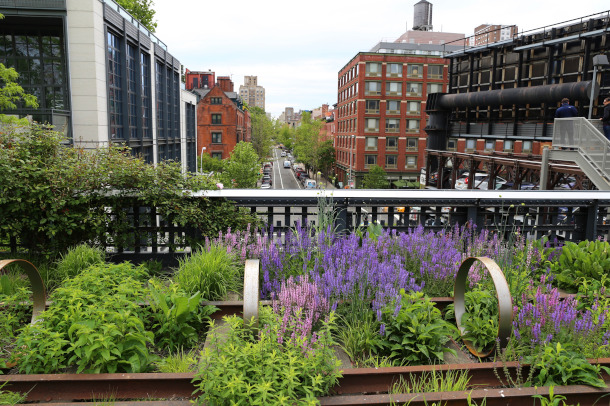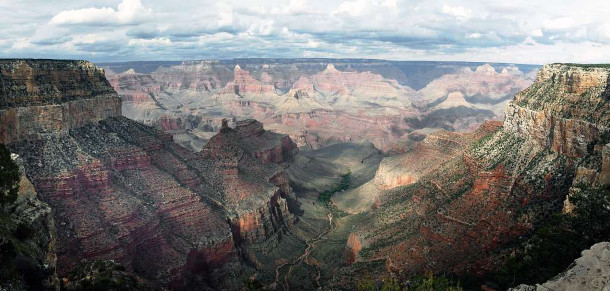Beyond the Headlines
Air Date: Week of January 13, 2023

A new study finds that the greenery in New York City absorbs as much carbon as all the traffic in the city emits on many summer days. (Photo: Neerav Bhatt, Flickr, CC BY-NC-SA 2.0)
In this week’s look Beyond the Headlines, environmental journalist Peter Dykstra and Host Steve Curwood admire the greenery in New York City, which a new study has reported absorbs as much carbon as all the traffic in the city emits on many summer days. They then discuss the climate implications of the Republican House Speaker battle before looking back at Republican President Theodore Roosevelt, who created the Grand Canyon national monument on January 11th, 1908.
Transcript
BASCOMB: It’s Living on Earth, I’m Bobby Bascomb
CURWOOD: And I’m Steve Curwood.
And with me on the line from Atlanta, Georgia is environmental journalist Peter Dykstra. Hi there, Peter, how are you doing? What do you have for a look beyond this week's headlines for us?
DYKSTRA: Hi, Steve. We're gonna start with a little bit of good news about the greenery in cities. There was a study that appeared in the journal 'Environmental Research Letters', carried out by Columbia University, and found that on many summer days, about 40% of greenhouse gases emitted in New York City, were offset by the city's greenery. Essentially, they offset all of the traffic emissions.
CURWOOD: Hmm. So that works great in the summer, as you say, Peter, but what about the winter because those cars and cabs and all that stuff keep going even when the leaves are gone from the trees?
DYKSTRA: Yeah, temperate cities around the world are all like that they lose much of their carbon emissions-absorbing ability in the wintertime. But at least in summer, not just big parks like Central Park and Van Cortlandt Park. But all the little backyard gardens and little patches of greenery throughout the city, do more than we had ever given them credit for, not only making New York a greener place, but greenery has shown in other research, that it makes New York a happier place, and other cities, and a less asthmatic place.
CURWOOD: And I imagine those trees as they absorb the CO2 are also soaking up some of the toxic chemicals that come out of the tailpipes of cars. So it's nice to get a bit of good news anyway, Peter, thank you. What else do you have for us today?
DYKSTRA: I wouldn't say that it's been beyond the headlines to discuss the new party in power in the House of Representatives, the Republicans, not being able to agree on their own Speaker of the House. But there are a couple of things that come out in terms of climate. One is that the hardliners on the Republican side in Congress, who are not only hardliners on conservative issues, but they're also climate deniers, they got more than their collective weight should have allowed them to bargain for in the Speaker's race. They're also part of the "drill baby drill" movement starting in 2008 that was associated with Sarah Palin's vice presidential campaign. Steve Scalise, generally considered to be the second most powerful Republican in the House of Representatives is also a big oil and gas man.

Kevin McCarthy was elected house speaker after a long battle among Republicans, hinting at the difficulty of passing climate policy in the coming years. (Photo: Gage Skidmore, Flickr, CC BY-SA 2.0)
CURWOOD: Well, of course, the Senate stays democratic and that was, of course, the folks along with the Democratic House that passed the Inflation Reduction Act otherwise known as the largest measure to address the climate in this country. But the House and the Senate, I guess, aren't going to agree on much in these next couple of years. What does that do for the climate situation?
DYKSTRA: It certainly lessens any promise that collectively Congress is going to get more serious about climate change. Let us not forget that the Republicans are also looking at a majority of their appointees to the Supreme Court and we'll have some cases coming before the Supreme Court in the next few years regarding climate change as well.
CURWOOD: Indeed. Let's take a look back in history, something about Republicans?
DYKSTRA: In January of 1908, more than a century ago, when a Republican was the most prominent conservationist in the country, that, of course, being Teddy Roosevelt, he made the Grand Canyon a national monument. It's a precursor to making the Grand Canyon a national park, that was actually done in 1919 by President Woodrow Wilson. Both Wilson, the Democrat, and Teddy Roosevelt, the Republican, were concerned that mining interests were beginning to encroach on areas not just near the canyon, but near sacred sites for many Native American tribes. And bear in mind that back in 1908, Arizona wasn't even a state yet. It didn't become a state for another four years.

The Grand Canyon in Arizona was declared a national monument by Theodore Roosevelt on January 11th, 1908. (Photo: Bernard Spragg, Picryl, public domain)
CURWOOD: And I believe now the world recognizes the Grand Canyon as a UNESCO World Heritage Site. And you have to say, Peter, when you go and you stand on the rim of the Grand Canyon, or if you make your way down it as I have a couple of times. It's just so powerfully awesome.
DYKSTRA: Who wouldn't recognize the Grand Canyon, one of the absolute breathtaking wonders of the world. But the Grand Canyon was finally recognized by Roosevelt in 1908 as an area to be treasured and protected.
CURWOOD: Well, we can be grateful for that. Peter Dykstra is an environmental journalist in Atlanta, Georgia. I want to thank you for taking the time with us today and we will talk again real soon.
DYKSTRA: Alright, Steve, thanks a lot and I'll talk to you soon.
CURWOOD: And there's more on these stories on the Living on Earth webpage that's LOE.org.
Links
Yale Environment 360 | “New York City Greenery Absorbing All Traffic Emissions on Many Summer Days”
E&E News | “3 Climate Takeaways from the GOP Speaker Meltdown”
History.com | “Theodore Roosevelt Makes Grand Canyon a National Monument”
Living on Earth wants to hear from you!
Living on Earth
62 Calef Highway, Suite 212
Lee, NH 03861
Telephone: 617-287-4121
E-mail: comments@loe.org
Newsletter [Click here]
Donate to Living on Earth!
Living on Earth is an independent media program and relies entirely on contributions from listeners and institutions supporting public service. Please donate now to preserve an independent environmental voice.
NewsletterLiving on Earth offers a weekly delivery of the show's rundown to your mailbox. Sign up for our newsletter today!
 Sailors For The Sea: Be the change you want to sea.
Sailors For The Sea: Be the change you want to sea.
 The Grantham Foundation for the Protection of the Environment: Committed to protecting and improving the health of the global environment.
The Grantham Foundation for the Protection of the Environment: Committed to protecting and improving the health of the global environment.
 Contribute to Living on Earth and receive, as our gift to you, an archival print of one of Mark Seth Lender's extraordinary wildlife photographs. Follow the link to see Mark's current collection of photographs.
Contribute to Living on Earth and receive, as our gift to you, an archival print of one of Mark Seth Lender's extraordinary wildlife photographs. Follow the link to see Mark's current collection of photographs.
 Buy a signed copy of Mark Seth Lender's book Smeagull the Seagull & support Living on Earth
Buy a signed copy of Mark Seth Lender's book Smeagull the Seagull & support Living on Earth

